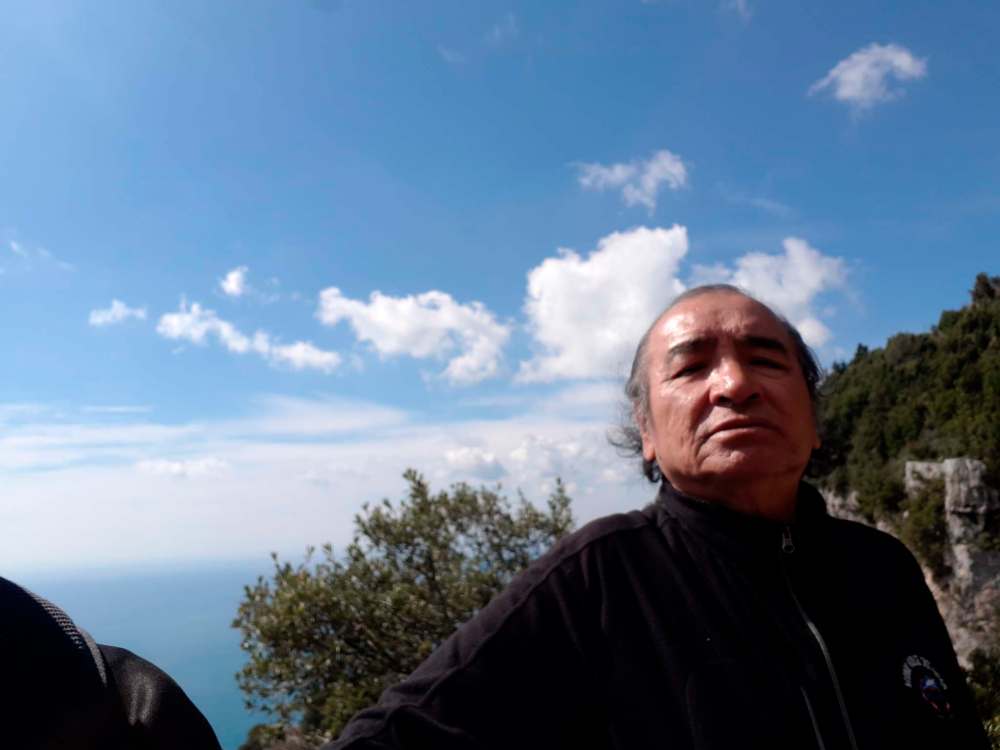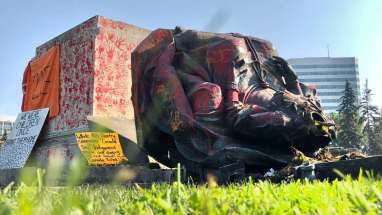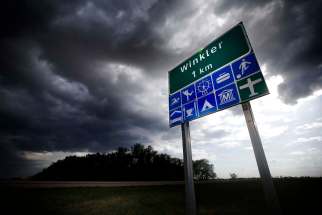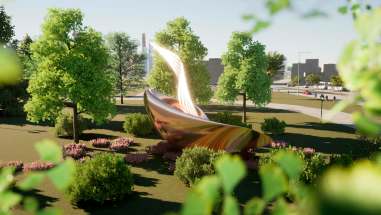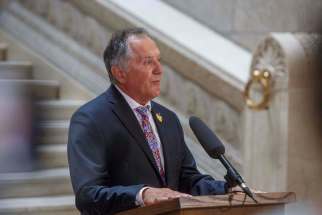Statuary holiday Time to take a break from honouring figureheads, celebrate province's pre-colonial history, Indigenous artists say
Read this article for free:
or
Already have an account? Log in here »
To continue reading, please subscribe:
Monthly Digital Subscription
$0 for the first 4 weeks*
- Enjoy unlimited reading on winnipegfreepress.com
- Read the E-Edition, our digital replica newspaper
- Access News Break, our award-winning app
- Play interactive puzzles
*No charge for 4 weeks then price increases to the regular rate of $19.00 plus GST every four weeks. Offer available to new and qualified returning subscribers only. Cancel any time.
Monthly Digital Subscription
$4.75/week*
- Enjoy unlimited reading on winnipegfreepress.com
- Read the E-Edition, our digital replica newspaper
- Access News Break, our award-winning app
- Play interactive puzzles
*Billed as $19 plus GST every four weeks. Cancel any time.
To continue reading, please subscribe:
Add Free Press access to your Brandon Sun subscription for only an additional
$1 for the first 4 weeks*
*Your next subscription payment will increase by $1.00 and you will be charged $16.99 plus GST for four weeks. After four weeks, your payment will increase to $23.99 plus GST every four weeks.
Read unlimited articles for free today:
or
Already have an account? Log in here »
Hey there, time traveller!
This article was published 16/07/2021 (1605 days ago), so information in it may no longer be current.
WHEN statues come down, it’s only natural to ask questions: who did they depict, what did they represent, who did they honour, who did they harm, which stories did they tell, which ones did they erase? Who decided to put them up in the first place?
Those are good questions to ask, and they’ve been percolating in Manitoba since July 1, when a pair of idols depicting Queen Victoria and Queen Elizabeth II, two British monarchs, were taken down by protesters who had split off from a peaceful Canada Day march in support of residential school survivors at the province’s legislative building.
As always happens when questions are asked, everyone concerned seems to have an answer: put them back, leave them down, keep them there as is. The province’s answer thus far has been to pledge the statue of Elizabeth will return to the east lawn, where it stood since 2010, and to restore the Queen Victoria statue to be placed elsewhere on the grounds. There have also been preliminary conversations about placing a statue of Chief Peguis, who signed the first treaty with Lord Selkirk in 1817, on the grounds in Victoria’s statue’s stead.
For more answers, and more questions, the Free Press spoke with playwright Tomson Highway, author David A. Robertson, artist and curator Daina Warren, Winnipeg Art Gallery curator Jaimie Isaac, musician Vince Fontaine, and artist Kenneth Lavallee, who was inspired to conceptualize a sculpture — of sweetgrass in a shell — to replace the one of Victoria the very day the statue came down.
● ● ●
Kenneth Lavallee had already returned home from the march to the legislature when Queen Victoria came tumbling down.
Then, the texts started flowing, telling the artist what had happened: “The Queen!” “The statue is down!”
“I saw the news, and I knew I had to act quick,” he says.
So Lavallee, who’d always been bothered and confused by the statue’s prominent location — “Why does she get the best seat in the house if she’s never even been here?” — began racking his brain, and opened his computer’s 3D rendering software with the intention of creating a sculpture to replace the bust of the ex-British monarch, who died in 1901.
He wanted to make something “not so colonial, not so authoritarian, something open to interpretation that everyone could see themselves in.
“It’s one thing to complain, but you really have to offer a solution and replace it with something better,” he says.
“It’s one thing to complain, but you really have to offer a solution and replace it with something better.” – Kenneth Lavallee
Lavallee found inspiration right under his nose: a shell and a braid of sweetgrass his mom had given him a few weeks earlier. The light of the computer monitor glimmered in the interior of the shell.
Sweetgrass is one of the four traditional Indigenous medicines found on this territory, Lavallee says, its smoke used in smudging ceremonies to “purify” and eliminate negative energy from the world. It was a universal enough symbol that felt like an appropriate metaphor, a form of healing sorely needed during a time of significant pain in the world.
He then got into the zone, spending the evening tinkering with his idea before finally completing his design at 1 a.m, after a span of only a few hours, even though the finished product — inspired in part by Anish Kapoor’s Cloud Gate (better known as the Bean sculpture) in Chicago’s Millennium Park — appears as though it took several days of labour. The next morning, Lavallee, who is Métis and from the community of St. Laurent, did the final renders before taking to social media with his images and ideas, something he often does to gauge public interest and opinion.
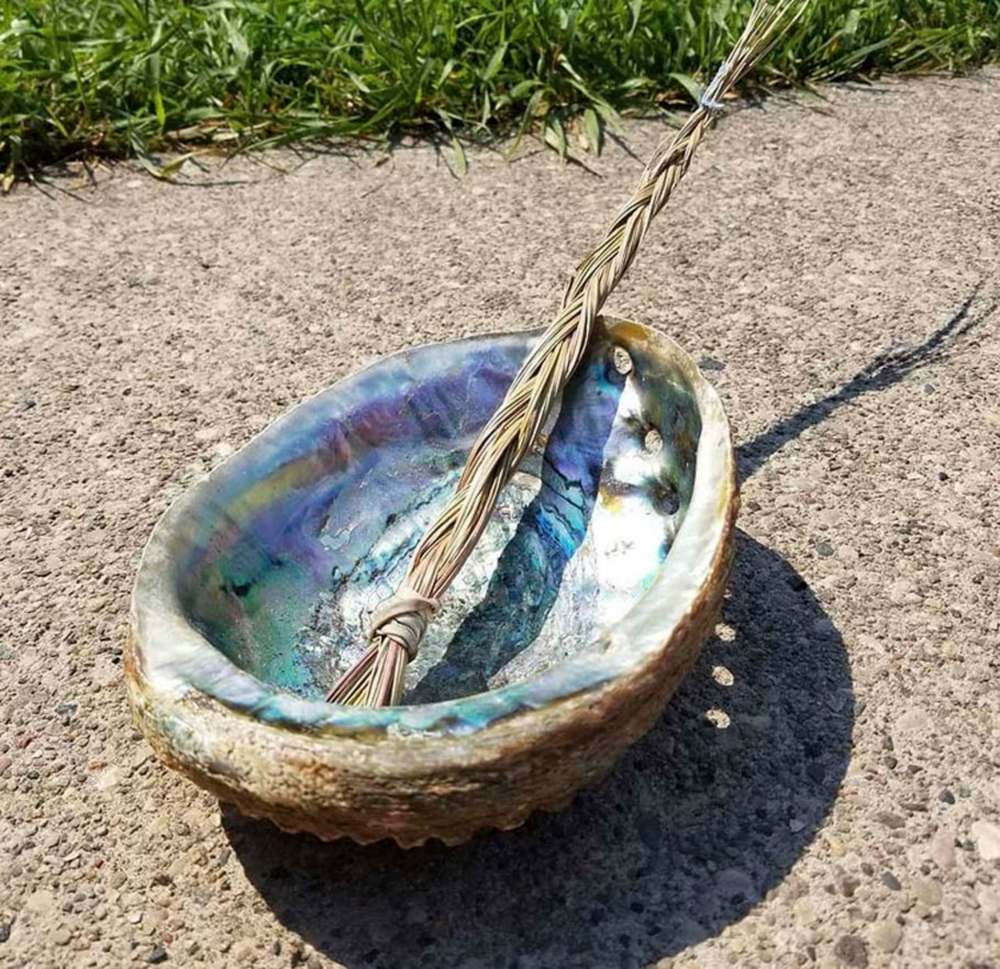
“Yesterday a statue of Queen Victoria seated on her throne, scepter in one hand globe in the other, which sat prominently in front of our Legislative building was pulled down by the people of Treaty 1 territory after 117 years,” he wrote. “After being covered in red paint (signifying the blood of thousands of Indigenous children who were killed by government and church-run residential schools) her head was removed and thrown into the Red River,” he wrote.
“I’ve long felt that she didn’t deserve this spot near the heart of our city — she’s literally never stepped foot on this soil yet has caused incredible amounts of damage and trauma to this day. Because of this, I’ve often thought about how to replace it with something relevant to everyone in Treaty 1 territory, something not about domination and subservience but peace and healing.”
“This is my idea for a new space in her place, which I hope can illuminate and steer our awfully dusty and ‘Victorian’ halls of government towards more inclusion, representation and respect for the land and everyone on it.”
He didn’t know what would happen next, but the response was swift. Thousands of people shared his post, commenting “Yes!” and “We need this!” Lavallee received hundreds of messages about his idea, which reinforced to him that it was a good one.
“At first I thought I’d been hacked,” he says. “I didn’t know where all this attention was coming from, but it was totally unanimous. For seemingly everyone on the internet to agree about something is pretty rare.”
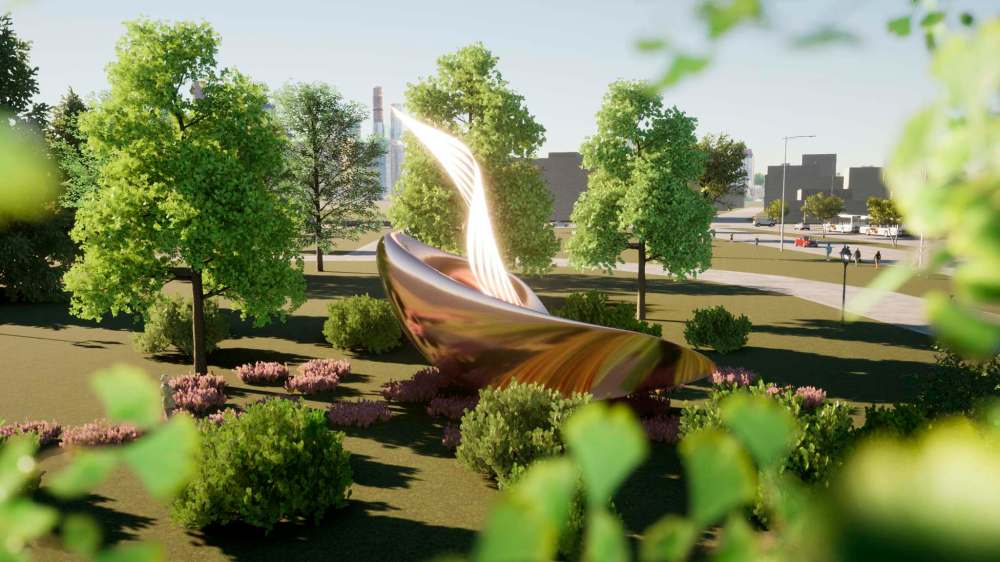
Indeed, while the removal of the statue of Victoria has led to serious debate online, Lavallee’s sculpture concept has been met with an overwhelming level of support from the art community and from commentators, although the artist is still waiting for the concept to become a reality.
“Eventually, I think it will reach the right people and I trust things will work out from here,” he says. “I’m hoping some higher-up will see it and at least we can start this conversation with some momentum.”
As for the statue of Victoria, which the province has said would be recovered and restored to potentially be placed elsewhere, Lavallee says the headless statue and the pedestal — covered in red handprints — is an important piece of history as it currently exists.
“I think that it would look great in a museum somewhere,” he says. “It’s a good artifact of this country’s frustration with its own history. To recast it in bronze and put it in the same place would be taking one step forward and two steps back.”
“As for the Queen Elizabeth one, that one doesn’t bother me as much,” he says.
But it didn’t sit well with Lavallee that the statue of Queen Victoria loomed over healing ceremonies, metres away from the sacred fire set up on the legislative grounds, as people grieved and prayed for the Indigenous children whose bodies were found in unmarked graves at residential school sites across the country.
“She had to go,” he says. “As a meeting place, I think it should be more open and natural. More inclusive, more inviting, more relevant.”
— Ben Waldman
● ● ●
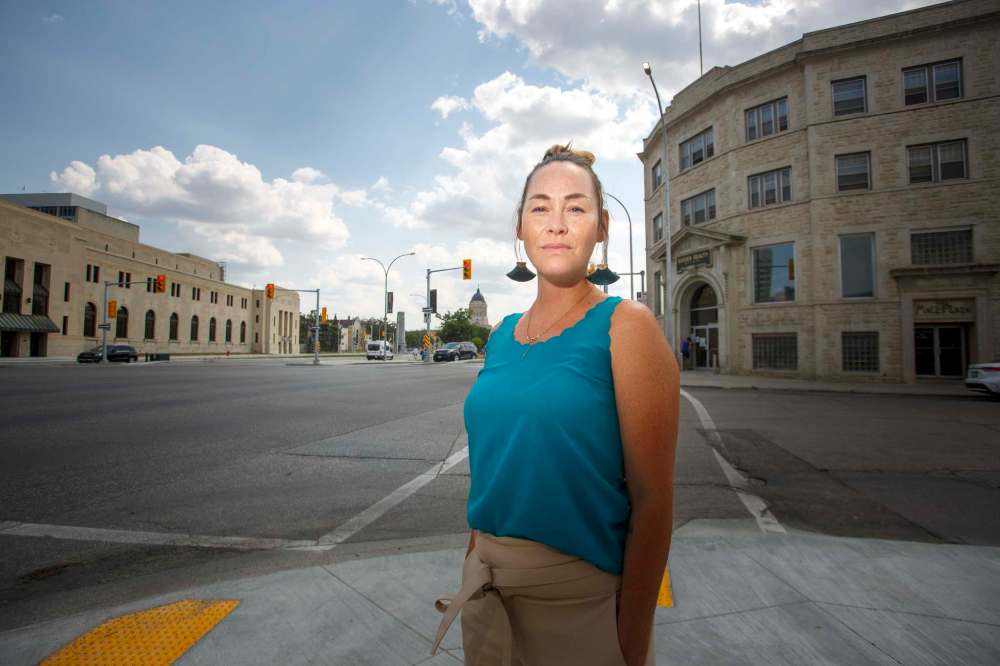
Back in 2016, Jaimie Isaac, now the curator of Indigenous and contemporary art at the Winnipeg Art Gallery, delivered a critical talk called Indigenous City: Affirming Our Presence Through Art.
“I’m going to welcome you again to Treaty 1 Territory and homeland of the Métis,” she began. “And I say that because, that fact is not identifiable in the city landscape.”
Isaac, a member of Sagkeeng First Nation of Anishinaabe and British heritage, pointed out the lack of Indigenous public art in Winnipeg, and how our monuments do not reflect the city or the people who live here. She spoke to the power of public art in decolonizing and Indigenizing public spaces — in large part because it’s, well, public. It doesn’t allow you to look away.
The city’s iconography has changed in the years since Isaac delivered that talk. Kenneth Lavallee’s star blanket murals are now draped over buildings all over town, honouring missing and murdered Indigenous women. Ian August’s giant tea kettle on the Southwest Transitway recognizes the Métis community of Rooster Town and the boil water advisories and lack of safe drinking water in many Indigenous communities. Air Canada Window Park, on Portage Avenue, is home to a collection of public art works by Indigenous artists called THIS PLACE: On Treaty 1 Territory and the Homeland of the Métis Nation. Isaac herself collaborated with KC Adams and Val Vint on Niimaamaa, the striking figure of a pregnant woman, representing motherhood, Mother Earth and new beginnings, that welcomes people to Niizhoziibean at The Forks. And that’s just to name a few.
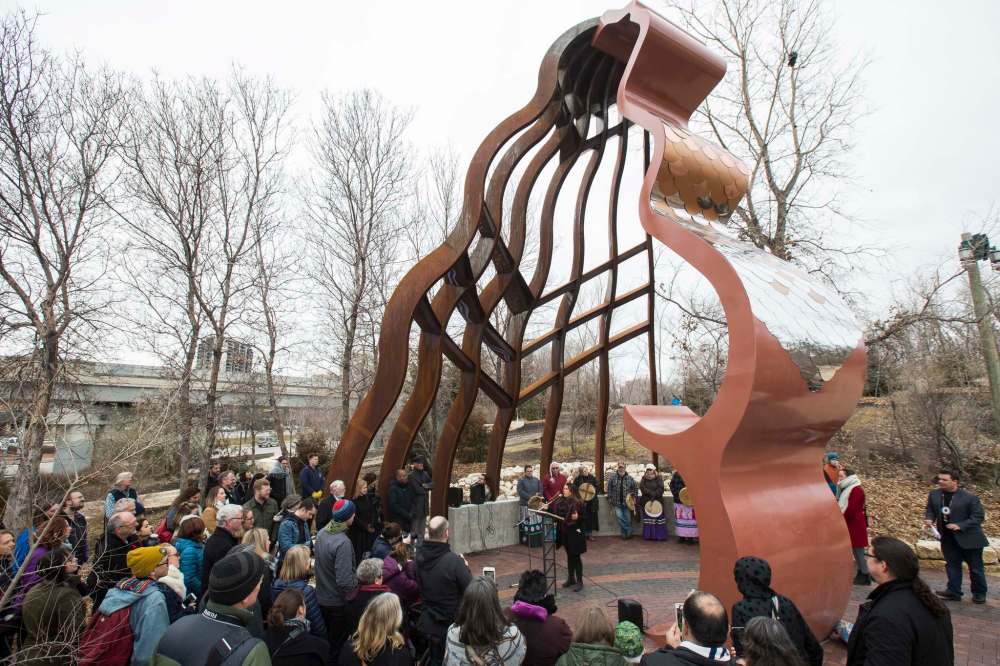
“It’s been amazing to see the landscape changing,” Isaac says. “I think we can only support that opportunity further, by taking a space like the legislature, and using that opportunity for real education and celebration for change. We’re past the point of honouring a colonial representative. And that change can only be exciting, right? We’ve got so many artists in the city.”
As for what she’d like to see on the Legislature grounds, “I think what would be more appropriate would be the history of Manitoba, in terms of Indigenous and Metis perspectives of this place, of this land, and to honour the histories before colonial implications on these lands,” she says. “I think it’s an opportunity to work with many Indigenous and Métis artists that we’re so lucky to have in the province.
“It would be so amazing to think about that space before the legislature, what was happening on that exact space before that big colonial building was built. What was the governance before a colonial governance ruled here? Those are some of the histories I think that would be really important to connect to the land there.”
Isaac points out that the timing for these conversations is right, too: this August marks the 150th anniversary of the signing of Treaty 1. She would love to see artworks that go beyond land acknowledgement, that acknowledge the truth. As she says, you can’t have reconciliation without the truth.
“Part of that truth is to understand that land and the politics of the treaties — I mean, they’re broken. They’re broken treaties,” Isaac says. “And we’re currently undergoing understanding that truth of the children in the unmarked graves and all the children that didn’t come home, missing and murdered Indigenous women and children — really understanding how those treaties broken have affected our society at large. I see these opportunities for that education. And I think that we can Indigenize our city by acknowledging truth and acknowledging the land in more ways than just talk.
“I think we’re heading in a time of truth, and that can really poignantly be brought out through public art.”
— Jen Zoratti
● ● ●

Daina Warren, curator and director of Urban Shaman Contemporary Aboriginal Art, is not one to advocate for the destruction or defacement of any art, even symbols of colonialism such as the Queen Victoria pulled from its pedestal on July 1.
“I understand the reaction to it and obviously the anger associated with everything that is happening,” Warren says. “Defacing things is not always the best way to go about addressing that bad (history).
‘But I totally appreciate the actions, and why they felt it was necessary to pull her down,” she says. “When I heard that (Premier Brian) Pallister was just going to replace her again, I find that really frustrating because he should be addressing what’s happening.
“When I heard that (Premier Brian) Pallister was just going to replace her again, I find that really frustrating because he should be addressing what’s happening.” – Daina Warren
“A lot of people are feeling like there’s just been a dismissal of the situation from him,” she says. “For me, I think it would be a good time for a change.”
Warren says the proposed work by artist Kenneth Lavallee would nicely fill that empty space.
“It’s really beautiful,” she says. “I think it would be really nice to see a memorial or some sort of object that would signify what’s been happening this year that would signify the idea of reconciliation.
“This is an important time for healing to take place,” she says. “Even if they do replace Victoria, there could still be a spot on the grounds for something like what Kenneth is suggesting, something to memorialize what’s been going on.
“This is a pretty big moment in Canadian history.”
— Randall King
● ● ●
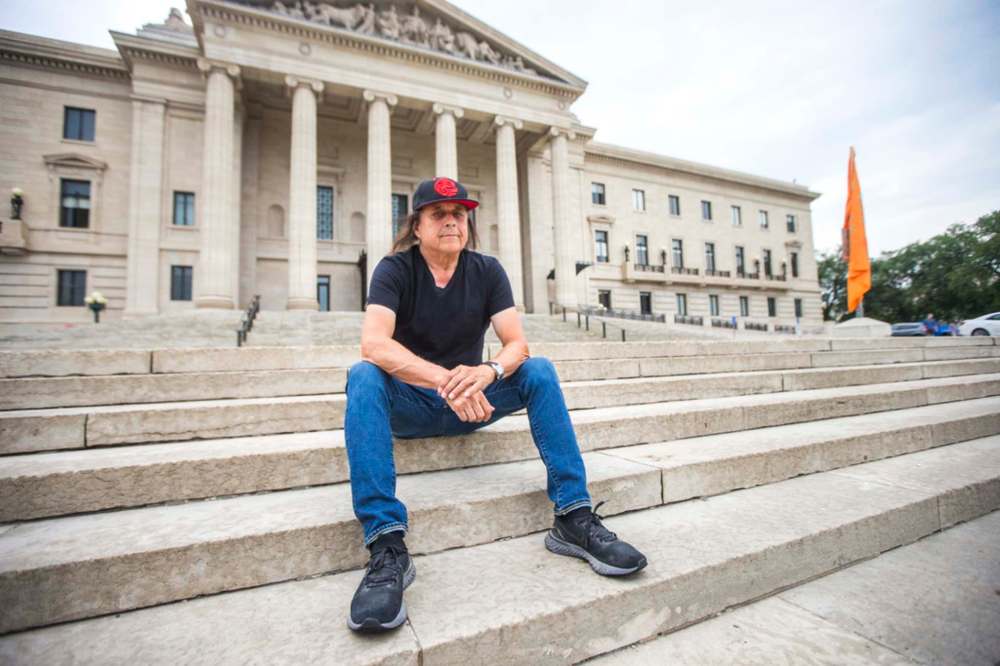
Though he’s against the destruction of property, Vince Fontaine doesn’t refer to the toppling of Queen Victoria’s likeness as an act of vandalism.
“It should be considered an act of social change,” says the lead singer of local bands Eagle and Hawk and Indian City. “The Indigenous people… we were toppled, it’s time for us to get up.”
For Fontaine, who is Ojibway from Sagkeeng First Nation, the recent discovery of unmarked graves at residential school sites across the country isn’t surprising — the Truth and Reconciliation Commission described as much in 2015 — but it is painful. His mother and eldest siblings are survivors.
“It’s directly part of my past and it’s also affected myself and everybody around me,” he says. “Directly, indirectly and ongoing.”
Fontaine was one of thousands who marched through downtown Winnipeg in a sea of orange on July 1. He didn’t witness the statue come down, but was struck by images of the bronze monarch and limestone plinth covered in red painted handprints.
“It’s very symbolic,” he says. “Some people may be outraged about the toppling… but the fact is this is really about human beings, little children, and you can’t compare it in any way.”
Fontaine doesn’t want the former queen returned to her throne. Instead, he’d like to see an Indigenous artist or artists come up with a new piece of public art that captures this moment in history and looks towards the future — not the colonial past.
He would also like to see prominent First Nation leaders celebrated with statues on the legislature grounds, pointing to Phil Fontaine, former head of the Assembly of Manitoba Chiefs and an outspoken residential school survivor, or past MLAs Elijah Harper and Eric Robinson as examples.
“One hundred per cent there should be an Indigenous person or persons or an expression of our art and voice and spirit,” he says. “This is really about the resilience of our people still being here… we’re trying to move the needle to equality and fairness and healing.”
As a musician who has spent his career writing songs about Indigenous perspectives and issues, the last few weeks have inspired new music.
“It’s one of the ways that I can (respond) as a human being,” he says. “Music is my vehicle and my podium.”
While Fontaine is buoyed by public outrage over the legacy of residential schools, he’s also lived through many other moments of national reckoning — like the Oka Crisis and the national inquiry into Missing and Murdered Indigenous Women and Girls. Meaningful change is going to be incremental, he says, “but I think Indigenous people are poised and they’re not going to step back.”
— Eva Wasney
● ● ●
In one way or another, directly or indirectly, Winnipeg-based Swampy Cree author David A. Robertson has written about residential schools, Indigenous experience and more in every one of his books, be they for children, young readers or adult.
His 2017 book When We Were Alone, illustrated by Julie Flett, won him a Governor General’s award; it tells the story of a grandmother recalling her residential school experience to her granddaughter.
Robertson and family attended the July 1 march, and he offered the following written reflection on his experience:
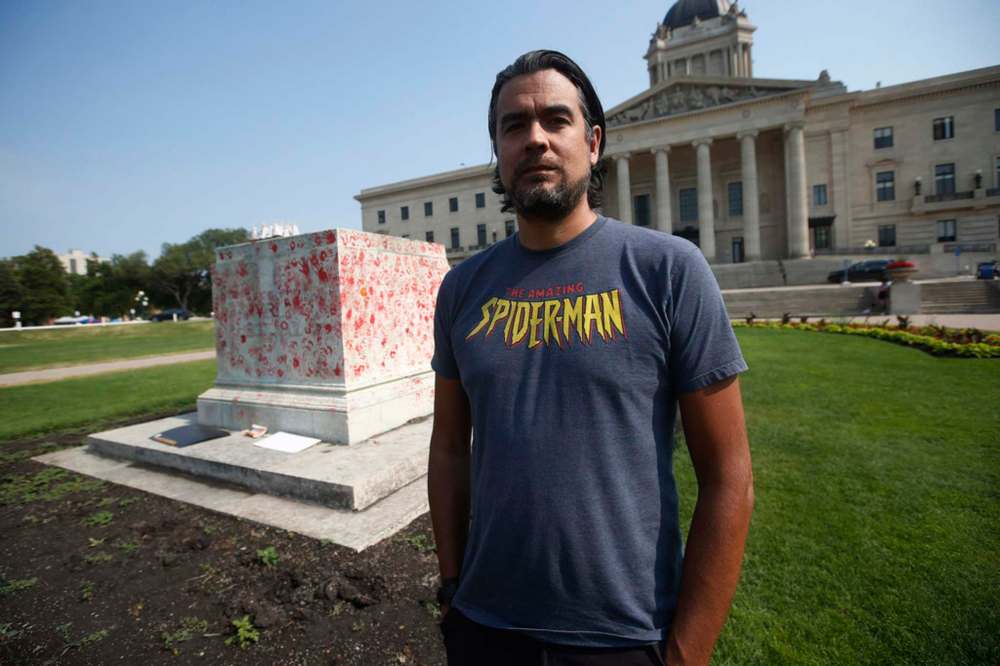
“On July 1, my family and I marched to the legislature along with hundreds of other Manitobans, Indigenous and non-Indigenous, all clad in orange. It was a protest against the historical and contemporary genocidal treatment of Indigenous people in this place we call Canada. It was to honour the survivors of the residential school system in Canada, the thousands and thousands of children who did not survive, and the discoveries of over 1,665 bodies (so far) lying in unmarked graves on former residential school sites.
“It was a beautiful day, a beautiful act of community, and a step on this path that we call reconciliation. There was also a palpable sense of anger, pain and mourning. People were still coming to terms with what had been done to Indigenous children, some as young as three, and coming to terms with the lack of meaningful action at all levels of government — municipal, provincial and, glaringly, federal, with this country’s prime minister bemoaning the loss of so many children “as a father” but at the same time taking survivors to court on appeal as a supposed leader.
“I was not there when the statues came down, but I’ve thought a lot about it since. I’ve come to grasp the irony of there being an event to commemorate children who were victims of the horrendous impact of colonialism, overseen by the statue commemorating a monarch whose reign coincided with the establishment of the Residential School System. And so, a small group of protesters brought the statue down.
“What I do know is that Indigenous people deserve better — and, frankly, if we truly want to be proud of this province, we all do.” – David A. Robertson
“Most Winnipeggers don’t agree with the statue coming down, or at least the way in which the statue was brought down. There are legal routes, of course. Bishop Grandin Boulevard, in the near future, will carry a different name thanks to strong advocacy work. Ryerson School in Winnipeg will also likely have a different name next school year thanks to students who stood up to demand better. But think about this: statues can be replaced — our unpopular, thick-skinned and thinly veiled racist premier will undoubtedly see to that — but thousands of children cannot be brought back.
“Indigenous children died, far more than we know about even now, in part because of the actions of people that we have chosen to immortalize. Macdonald. Ryerson. Grandin. And yes, Victoria. Make no mistake — statues do not document history, and so taking them down does not erase it. And isn’t it interesting that we’re actually discussing the erasure of history within the context of statues that honour the colonial figures in this country, that we have the audacity to do that when, I’m guessing, you were never taught about the residential school system if you went to school in the 1980s and ’90s.
“Let’s say that we demand better of ourselves, and no longer honour the architects of genocide. Let’s say that we don’t put the statue of Queen Victoria back up, despite what Brian Pallister might intend, and choose to instead honour something we as Manitobans, as Canadians, can be proud of. Honestly, I don’t know what that something is — a statue of a figure who has worked to build a people up rather than attempt to break a people down, a symbol of our commitment to reconciliation, something that is reflective of what this province is, or what it can be.
“What I do know is that Indigenous people deserve better — and, frankly, if we truly want to be proud of this province, we all do.”
— Ben Sigurdson
● ● ●
Manitoba-born playwright Tomson Highway is forthright in his distaste for replacing statues of living or dead English monarchs on the grounds of the legislature with more statues of living or dead English monarchs.
“The Royal Family is f—ing boring,” the 69-year-old playwright says in a phone interview from his home in rural Ontario, recalling seeing outsize monuments to Queen Victoria in both Calcutta and Rome.
“Enough already,” he says. “We need another statue of Queen Victoria like we need a hole in the head.”
He has a suggestion for a replacement: a statue of his own late younger brother, René Highway, a dancer and choreographer who died of AIDS in 1990 at the age of 35.
“He was stunningly, unbelievably beautiful,” Highway says. “People would say that he was the most beautiful man they’d ever seen.”
“Enough already. We need another statue of Queen Victoria like we need a hole in the head.” – Tomson Highway
While sheer beauty may be its own reward in statuary, Highway says there was more to his brother than that.
“He left behind an immense legacy,” Highway says. “And that legacy is Native theatre and Native performing arts and literature as well. They are flourishing today and if you trace the development of this entire movement to any one person, the person who took that first step and opened that first door, it was him.
“He did it very humbly,” Highway says. “He never got an award for it. He just did it very quietly and very beautifully.”
In fact, Highway was already seriously planning to erect a statue to his brother in Toronto in the vicinity of the Toronto Dance Theatre near the intersection of Winchester and Carleton in Cabbagetown.
“I was going to pay for it myself,” he says. “I was willing to pay $100,000. Apparently that’s what the life-size statue costs in bronze and I was planning on doing out in the next five years with fundraising and everything else.”
“He (René Highway) left behind an immense legacy. And that legacy is Native theatre and Native performing arts and literature as well.” – Thomson Highway
But Highway had a conversation with his longtime partner Raymond Lalonde, who asked him: “Why not erect the statue in Winnipeg instead of Toronto?”
“He started training at the Royal Winnipeg Ballet,” Highway says. “It would create a sensation. It would be a national shrine.”
Furthermore, Highway says he would be willing to put up $50,000 himself for the cause.
“My brother died 30 years ago and he’s very much with me every day and in all the work that I do,” Highway says. “With great difficulty, he opened the door to all these other artists who have walked through that door, who are now movie stars or literary stars, and Native theatre companies across the country from Halifax to Victoria.
“It was his doing. He did that.”
— Randall King

In a way, Randall King was born into the entertainment beat.


Ben Waldman covers a little bit of everything for the Free Press.


Jen Zoratti is a Winnipeg Free Press columnist and author of the newsletter, NEXT, a weekly look towards a post-pandemic future.
Our newsroom depends on a growing audience of readers to power our journalism. If you are not a paid reader, please consider becoming a subscriber.
Our newsroom depends on its audience of readers to power our journalism. Thank you for your support.

